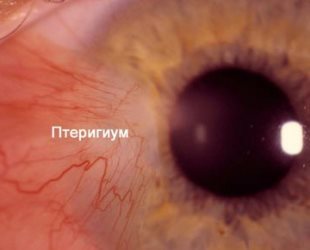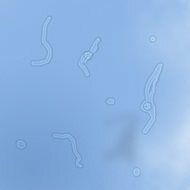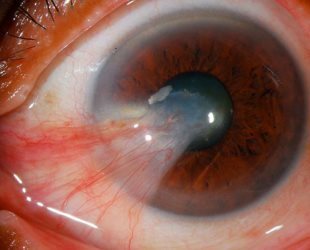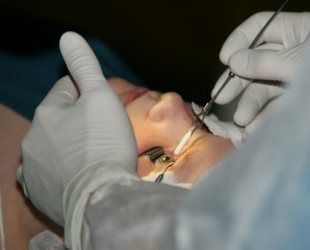
One of the most common eye diseases is the pterygium. Its other name is the pterygoid.
This disease of the conjunctiva of the eye is characterized by the fact that the degenerately changed conjunctival tissue grows and there is a formation in the form of a triangle that can grow on the cornea of the eye, thereby impairing sight.
In general, the pterygium occurs at the inner edge of the eye, near the bridge of the nose.
- 1. Causes of the disease
- 2. Development of the disease
- 3. Symptoms of the disease
- 4. Diagnosis of the disease
- 5. Possible complications
- 6. Treatment of the disease
- 7. Prevention of the disease
The growth can appear directly in both eyes. The pterygium can proceed in a progressive form( when the lesion rapidly increases in size) or be stationary( do not change in size).
Dimensions of the build-up can also be different: small, not damaging to the eyes and having only a cosmetic defect, or large, highly visible, touching the cornea and reducing vision.
Causes of the disease
There are no precise reasons for the onset of this disease, but factors that greatly stimulate the appearance of the pterygium are identified. Among them:
- genetic predisposition( quite often the possibility of the appearance of a pterygium is inherited);
- negative effects of ultraviolet radiation( traditionally more susceptible people living in southern countries and areas);
- negative environmental factors( dust, strong wind, smoke, etc.);
- prone to frequent various inflammations of the conjunctiva( including the appearance of pinguecula);
- harmful effects of office work( computer, air conditioning).
In general, the appearance of this disease does not affect the age and sex of a person , but according to statistics, most often the pterygium appears in men, perhaps because of their attitude towards certain professions and activities. In young people, the pterygium is rarely diagnosed. Basically, it occurs in people 25-40 years old.

Not clear eyesight, "flashed" flies? Find out why - the reasons for flies before your eyes. How to treat and what kind of prevention?
Is there a difficulty in outflow and blood flow in the lumen of the vessels? Here about the treatment of retinal angiopathy.
Development of the disease
Under the influence of the above factors and with constant irritation of the eye conjunctiva, the vascular pattern of the eyeball changes.
With prolonged similar effects, the structure of the connective tissue on the surface of the eye also changes. Of the large number of vessels that appear, fibroblasts fall into the eye envelope, which begin to form a connective tissue on the conjunctiva. So the pterygium grows.
Symptoms of the disease
In this conjunctival pathology the following symptoms are observed:
- cloudiness on the surface of the eye;
- appearance of a noticeable opaque growth on the cornea;
- sense of foreign body in the eye( since the pterygium starts to rise above the cornea, sensitive receptors on the inner side of the eyelid perceive it as a foreign object);
- irritation and dryness in the eye( there is no tear film on the surface of the build-up, and this film is broken on the surface of the cornea);
- if the pterygium grows on the center of the cornea, visual acuity decreases;
- with inflammation of the neoplasm observed redness, swelling, itching of the eyes, increased tearing.
Diagnosis of the disease

Often people first do not notice the appearance of the pterygium until it begins to increase in size.
But it is useful to prevent the growth of the build-up before it reaches the cornea of the eye, since otherwise the operation can leave consequences in the form of blurred vision.
Diagnose the pterygium with the naked eye. For the purpose of finding out the causes and characteristics of the disease, a special microscope( slit lamp) is used, the visual acuity is checked, and keratotopography is used( a method of studying the features of the cornea, usually done before operations on the surface of the eye).
Possible complications of
One of the negative possible consequences is that often relapses of the disease even after removal of the pterygium, and they can be even more aggressive than the first time. Another possible complication can be attributed:
- distortion of vision or reduced visual acuity;
- irritation and redness of the eyeball;
- appearance of scars on the eye surface( on conjunctiva and cornea);
- decreased mobility of the eyeball, which can lead to diplopia( double vision of visible objects);
- thinning of the cornea under the growth;
- is rare, but it is possible the degeneration of the epithelial tissue of the pterygium into a malignant one.
Treating the disease
The pterygoid cannula is treated with a conservative method with the help of medications or surgically.
If the problem is only a cosmetic defect, the pterygium does not interfere with vision and does not increase in size, it can not be removed. Such patients are recommended moisturizers( artificial tear) and anti-inflammatory drugs.
A surgical operation is prescribed to eliminate the pterygium. After a simple operation, relapses often occur, so doctors use various methods to prevent relapses: laser surgery( when the head is pinched by the head of the pterygopalon), conjunctival grafts that cover the eyeball shell at the injury site with a special glue or seam. Also to prevent the occurrence of relapses, use mitomycin C or liquid nitrogen, photodynamic therapy, etc.

After removing the formation for several days, it is recommended to treat the eyes with anti-inflammatory
After removing the formation for several days, it is recommended to treat the eyes with anti-inflammatory and antibacterial drops and ointments( eg, Levomycetin, Tebridex).
In any treatment, especially in the surgical, there may be some complications, for example, an improper transplant or an allergic reaction to the suture material, so it is necessary to consult before the operation and hold it only with highly qualified specialists.

Find out why itchy eyes? What is it, a diagnosis or a symptom? How to diagnose and treat?
Here about the main reasons for the development of pinguecula eyes.
What is nystagmus, what are the causes and methods of treatment?http: //moezrenie.com/bolezni/ glazodvigatelnii-apparat / nistagm-lechenie.html
Prevention of the disease
To prevent disease, it is necessary to avoid negative environmental factors:
- protect the eyes from ultraviolet radiation with sunglasses and wide-brimmed hats;
- prevent the ingress of dust and chemicals into the eyes;
- to observe the mode of work and rest when working at the computer.
If you observe all these precautions, the appearance of unpleasant growths in your eyes can be avoided.
At the slightest discomfort in the eyes it will be better to consult an ophthalmologist for professional and timely help.
